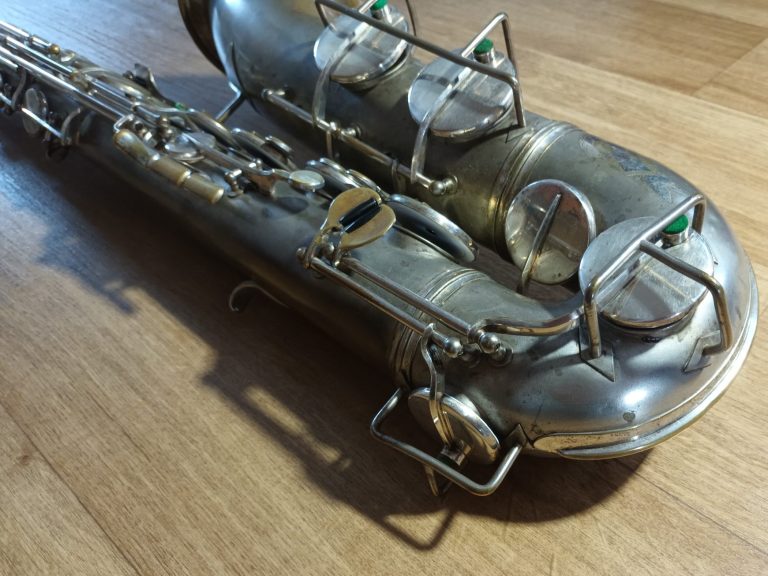Selmer Pennsylvania Special Saxophones
These are unique to the United Kingdom and more are appearing on the market from house clearances and estate sales.
I have been trying to find more information about them. The ones which have been though the workshop have been reasonable to work on and sound fine. They are affordable too.
I feel that people want vintage saxes for the sound but don’t always feel comfortable taking a valuable or rare instrument to a gig. These Pennsylvania saxes could be just the thing to fill the gap.

History
Selmer London started in 1929 selling Henri Selmer - France saxophones. It grew and became a large retailer of a wide range of musical instruments.
By the mid-1950s the owners had become less interested in musical instruments and moved onto other things which were profitable at the time. By the 1970’s the company was in new hands selling organs and guitar amplifiers. As with a lot of manufacturing in the United Kingdom – it came to a close in the late 1970’s.
Musical instrument shops were quite rare in the 1900’s and people would make a special trip to London to buy their instrument. Many of the shops were based in Denmark Street, Soho, London. Not many shops survive now, internet shopping now makes it easy to see all the products and supply chains have improved so you can view products at stores closer to home.
Just like now, instruments were sold on credit, but back then it was called hire purchase and the customer would have to go to the store each week or month to pay. This would be impractical for people travelling in from out-of-town so that would be why these instruments mainly appear outside of London.
By researching the information available I found the main problem seems to be that the brand ‘Pennsylvania Special’ was put onto a wide range of instruments from all over the world. The variety suggests that they were commissioned in small batches probably annually with a reasonable manufacturer.
They are all ‘stencil’ instruments. This means they were made by a manufacturer of note on the same production line as their own instruments. Usually, the engraving is the only difference between the premium model and the stencil. The serial numbers usually follow the original manufacturer’s scheme.
Who made them?
- 1930’s - Pennsylvania Special
- Engraved "Made in Czechoslovakia"
- Made by Keilworth, Kolhert or Kohler
- There are at least two variations – One has engraving on the bell, bow and neck, the other has a small engraving above the bell keys only.
- Some have pearls on all the touch points in the style of a Martin typewriter.
- Altos may have an underslung octave lever.
- The key guards are the wire type
- They have rolled tone holes
- Keilworth left Czechoslovakia in 1938.
- Amati were formed from Kolhert, Kohler and others in 1945
- 1960’s Pennsylvania:
- Made by Ida Grassi, Orsi and others in Italy.
- These have pressed metal key guards.
- Have a Super Balanced Action look to them but with the old style pinkie finger cluster.
- 1970’s Pennsylvania Super
- Made by Yanagisawa.
- The bell to body brace is a very large ring.
- A lyre logo is engraved on the bell – maybe on the body or neck octave lever. It must be there somewhere for provenance.
Other sub-brands such as ‘Selmer Bundy’ and ‘Selmer London’ were made by makers of note such as Conn, Buescher, Karl Meyer & Martin (USA) and Keilworth (Germany).
Since there is so much variation and few records – it is possible to find the original manufacturer by:
• Looking at the left-hand pinkie key plate. Some manufactures like Conn have a distinctive style.
• General lacquer wear
• The case
• Engraving
• Comparing to premium brand models made at the time
Are they a good purchase?
Benny Carter played one during his time in London. They are all made by reputable companies.
If you are after a vintage saxophone without the worry of taking a valuable instrument out, these may work well for you.
Like all old instruments, they can take a while to adjust to but can deliver an authentic sound and look to a performance.
Be wary if an instrument is old and looks like it has been hardly used. It may have problems which could be difficult to fix. A care-worn instrument is usually fine after it has been serviced.
Don’t expect any instrument at auction to be in good playing order unless the seller says they have been serviced or refurbished and the photos show the pads are in good condition. A service and repad is likely to cost way more than the instrument for a private buyer. For me, it’s not an issue; I can restore and sell with small margins.
If you like how it looks, try it. You may get a usable bargain vintage saxophone. Off-brand vintage saxophones are unlikely to depreciate further and do not suffer from the price fluctuations of premium instruments.
We need your consent to load the translations
We use a third-party service to translate the website content that may collect data about your activity. Please review the details in the privacy policy and accept the service to view the translations.

